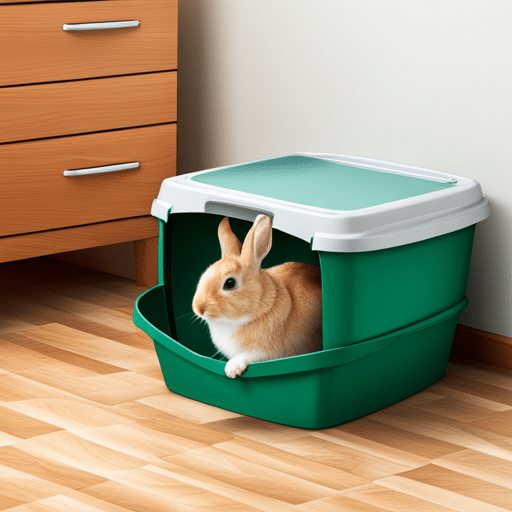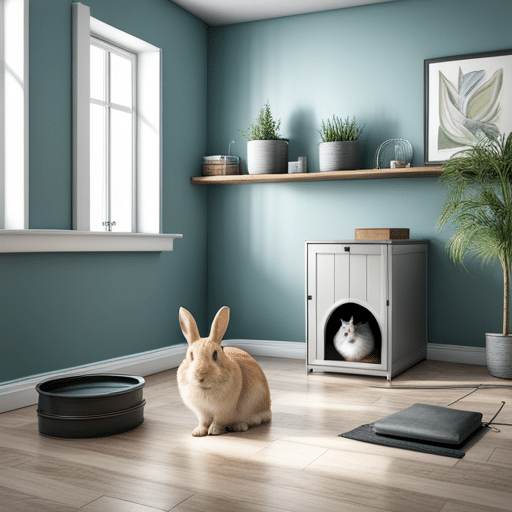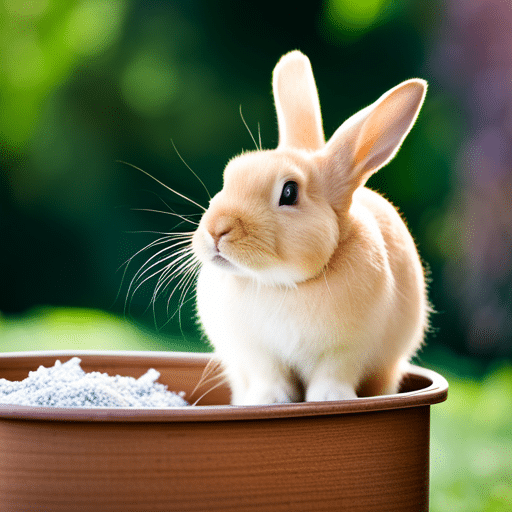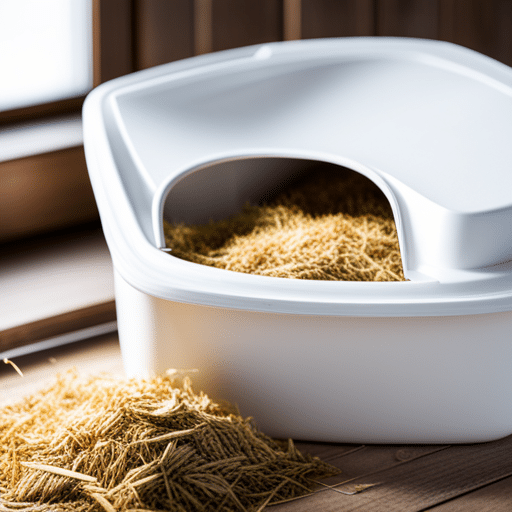Did you know that learning how to litter train your rabbit can make your life and theirs much easier and cleaner? Not only does it save you time and effort in cleaning their living space, but it also allows you to monitor their health through their elimination habits, which is especially important for a house rabbit. In this comprehensive guide, we will walk you through the essential supplies and techniques needed for successful litter training, ensuring that you and your rabbit enjoy a harmonious and hygienic living environment.
Introduction to Rabbit Care
Rabbit care involves providing a safe and healthy environment for your pet rabbit. One essential aspect of rabbit care is litter training, which helps maintain a clean and hygienic environment for your rabbit. Litter training involves teaching your rabbit to use a litter box, which can be a challenging task, but with patience and consistency, it’s achievable. A litter box is a crucial component of rabbit care, and it’s essential to choose the right type of litter box and litter to ensure successful litter training. Pet rabbits, such as house rabbits, require regular litter box cleaning to prevent the buildup of bacteria and odors.
Key Takeaways
-
Essential supplies, litter materials, and box design should be selected with your rabbit’s size in mind.
-
Create a comfortable environment by providing appropriate bedding and gradually expanding their living area as habits improve.
-
Positive reinforcement techniques and spaying/neutering can help reinforce good litter box habits, while maintaining hygiene is essential for health monitoring.
-
Ensure you have more litter boxes available, especially during the initial stages of training, to help your rabbit learn faster and develop good habits.
Essential Supplies for Litter Training

Having the appropriate supplies at hand is a vital first step in successfully litter training your rabbit. These include a suitable rabbit litter box, appropriate litter, and proper cleaning tools. Selecting the correct type of litter is paramount due to the potential harm some materials can cause to your rabbit. Paper-based or organic litter is a good option, while materials like pine, cedar, and clumping clay should be avoided. If your rabbit does not seem to like a particular type of litter, you can try switching to a different litter to ensure their comfort and safety.
A rabbit litter box should be designed with your rabbit’s size and comfort in mind, allowing them easy access and a sense of security. Keep in mind that rabbits, being naturally clean animals, usually choose designated areas, often corners of their enclosure, to defecate. So, having multiple litter boxes, especially during the initial stages of training, may help your rabbit learn faster and develop good litter box habits.
Being patient and persistent is vital, given that the learning pace can vary among rabbits.
Choosing the Right Litter
When selecting litter for your rabbit, safety should be your top priority. Rabbits have delicate lungs, and certain types of litter may contain harmful chemicals that could cause liver damage. When choosing a litter, the best option is to pick organic or natural materials. Examples include:
-
alfalfa
-
wheatgrass
-
oat
-
citrus
-
paper
-
compressed kiln-dried sawdust
Organic litter is not only safe but also eco-friendly, as it can be composted or used as mulch.
Pine, cedar, and clay litter should be avoided, as they can release harmful chemicals and cause respiratory issues.
Besides the litter material, including hay in your rabbit’s litter box is of great importance. Fresh, green hay like timothy hay, bermudagrass, or other rabbit-safe options is ideal. Hay not only promotes healthy litter habits but also encourages your rabbit to eat hay, which is an essential part of their diet. Place a handful of hay in the corner of the litter box to encourage rabbits to use it for both eating and going to the bathroom. It is important to choose safe litter options, as certain types of litter can pose a health risk if a rabbit eats them.
Selecting a Suitable Litter Box
Choosing the right litter box for your rabbit involves considering factors such as size, accessibility, and design. Your rabbit’s litter box should be large enough for them to move around comfortably and turn around easily. Ensure the box is easy for your rabbit to enter and exit, especially for older rabbits that may have mobility issues. Using litter pans with familiar scents, like droppings and urine, can encourage your rabbit to use them.
To help your rabbit feel secure while using the litter box, consider providing some cover, like a covered litter box or a towel draped over part of the box. If your rabbit has a habit of kicking litter out of the box, you can try a covered litter box, experiment with different litters, or use a sifting cat pan with litter beneath the sifting tray and hay on the surface. Consider using a urine guard to prevent litter from being kicked out of the box, ensuring a cleaner environment.
Setting Up the Rabbit’s Environment

Success in litter training hinges on creating a comfortable and conducive environment. This includes:
-
Selecting an appropriate enclosure size
-
Ensuring the enclosure is large enough to accommodate the litter box, food and water bowls, and toys, and still provide ample space for your rabbit to move around
-
Keeping in mind that rabbits generally prefer to use one or a few designated areas for elimination, usually in the corners of their living space
Creating a designated rabbit area within the enclosure can help promote proper litter box usage and reduce territorial marking.
You should also consider the location of the litter box within the enclosure, as this can impact your rabbit’s litter habits. Placing the litter box in a consistent spot, such as a corner, can help promote good habits and make it easier for your rabbit to locate the box when needed.
Creating a Comfortable Space
Start with providing appropriate bedding like paper-based litter, aspen shreds, specialist litter, or pellets to establish a comfortable space for your rabbit during litter training. Ensure that the bedding is non-toxic, as rabbits may ingest it, and keep in mind that some rabbits may prefer a flatter bedding design.
During the initial stages of litter training, confining your rabbit to a smaller space proves beneficial as it aids them in locating the litter box when necessary and promotes overall cleanliness. As your rabbit’s litter habits improve, you can gradually provide them with more space to explore and exercise.
Litter Box Placement Tips
When it comes to placing litter boxes in your rabbit’s environment, it’s important to choose the right location. Since rabbits tend to select corners for elimination, placing the litter box in a corner can give them a sense of security and comfort. If your rabbit consistently uses a specific corner for elimination, place the litter box in that corner to reinforce their habits. Rabbits choose specific areas, often corners, for their elimination needs, so placing the litter box in these preferred spots can enhance the training process. Provide multiple litter boxes if your rabbit prefers to go in different corners of the house.
If you notice your rabbit heading to a corner of the room where there’s no litter box, gently herd them back to their enclosure or a nearby litter box. Consistent litter box placement is essential for reinforcing good habits and helping your rabbit associate the box with elimination.
The Litter Training Process

The process of litter training your rabbit involves several steps:
-
Start litter training by placing a litter box in their enclosure and one or more boxes in their running space.
-
Begin with at least two litter boxes to help your rabbit learn faster and develop good habits.
-
Initiate the litter training as soon as you litter train your rabbit and bring them home for the highest probability of success.
Successful litter training requires patience and attentiveness due to the time and effort it might take for your rabbit to consistently use the litter box. Some rabbits may take longer to learn than others, and older rabbits may be more amenable to litter training than younger ones due to their increased capacity for concentration. Older rabbits are easier to train than younger rabbits due to their longer attention spans. When your rabbit starts to consistently use the litter box, it is a sign that they are beginning to understand the training process.
Starting Small and Gradual Expansion
To begin the litter training process, confine your rabbit to a restricted area within your home. Litter box training your rabbit can be a daunting task. However, with the right steps taken, this process can become much smoother and easier. As your rabbit becomes more consistent with their litter habits, you can gradually expand their living area, allowing them increased freedom and space to explore. Using multiple training boxes in the initial stages can help guide your rabbit’s habits and make the training process smoother.
Close monitoring of your rabbit’s progress throughout the litter training process is necessary, which includes adjusting the size of their living area as required. The number of litter boxes can be reduced as their litter habits improve. This will give your home a cleaner and tidier look. Remember to remain patient and persistent, as some rabbits may take longer to learn than others.
Positive Reinforcement Techniques
Positive reinforcement plays a significant role in litter training your rabbit, assisting them in associating rewards like treats, praise, or toys with desired behaviors. When your rabbit consistently uses the litter box, reward them with affectionate petting, words of praise, or small food treats. Gently guiding your rabbit back to their litter box when they head to a corner without a box can also help reinforce good habits.
Positive reinforcement helps ensure that your rabbit becomes litter box trained, making it easier to maintain a clean environment.
Remember that consistency is key when using positive reinforcement techniques. Reward your rabbit every time they exhibit desired behaviors, such as using the litter box, peeing and pooping in the box, and showing interest in the box by sniffing or exploring it. This will help create positive associations and encourage your rabbit to repeat the behavior in the future.
Common Mistakes to Avoid
One of the most common mistakes to avoid when litter training your rabbit is not providing enough litter boxes. Multiple litter boxes can help prevent accidents and make cleaning easier. Another mistake is not cleaning the litter box regularly, which can lead to the buildup of bacteria and odors. It’s also essential to avoid using the wrong type of litter, such as clay litter or clumping litter, which can be harmful to your rabbit. Using a litter box that’s too small can also lead to accidents and make litter training more challenging. You can use a litter box train or a covered litter box to make the process easier.
Common Challenges and Solutions
Rabbits may face several challenges during the litter training process, such as hormonal behavior, digging, and stubbornness. Successful litter training necessitates addressing these issues. Spaying or neutering your rabbit can significantly reduce hormonal behavior, making it easier to litter train them. If your rabbit tends to dig in their litter box, provide alternative play options or make modifications to the litter box to discourage this behavior. If you have a stubborn rabbit, be prepared to invest more time and patience in the training process.
If your rabbit is stubborn and refuses to use the litter box, try the following:
-
Place another litter box in the area where they consistently eliminate.
-
Be patient and persistent, as some rabbits may take longer to learn than others.
-
If you suspect your rabbit has a medical issue, such as a bladder infection, that’s preventing them from using the litter box, consult a veterinarian.
Spaying/Neutering and Litter Training
One of the most essential components of successful litter training is spaying or neutering your rabbit. This procedure can greatly improve their behavior during litter training by reducing the hormones that trigger territorial conduct, leading to a reduced compulsion to mark their territory. Spaying or neutering can also reduce behaviors like spraying urine, which are driven by territorial instincts. It’s recommended to spay or neuter your rabbit between 4-6 months of age for the best results in litter training.
By spaying or neutering your rabbit, you not only improve their litter habits but also contribute to their overall health and well-being. It reduces the risk of certain cancers and other health issues and can help your rabbit live a longer and happier life.
Dealing with Digging Behavior
If your rabbit has a habit of digging in their litter box, it’s essential to address this behavior to ensure successful litter training. One strategy is to provide alternative play options, such as:
-
Tunnels
-
Hideouts
-
Wooden toys
-
Digging boxes
These options can divert their attention from the litter box, making it essential to litter box train your pet until they are litter trained and consistently using their litter tray.
Another approach is to make modifications to the litter box itself. Using a covered litter box or experimenting with different types of litter may help discourage digging behavior. If your rabbit kicks litter out of the box, consider using a covered litter box or placing a mat around the box to catch the litter. By addressing digging behavior, you can help your rabbit develop better litter habits and maintain a cleaner environment.
Maintaining Litter Box Hygiene

For the maintenance of your rabbit’s health and well-being, it’s vital to keep their litter box clean and odor-free. A clean litter box also allows you to monitor your rabbit’s elimination habits, which can provide valuable insights into their overall health. To ensure proper hygiene, it’s important to clean the litter box daily, removing soiled litter and replacing it with fresh material.
In addition to routine cleaning, deep cleaning the litter box once a week is recommended to remove any stubborn stains and lingering odors. Natural, pet-safe products like white vinegar water solution and baking soda can be used for deep cleaning. By maintaining a clean and hygienic litter box, you help ensure the health and happiness of your rabbit.
Cleaning Techniques and Products
Spot-cleaning with a litter scoop 1-2 times daily and executing a deep clean weekly with white vinegar and mild dish soap are effective methods for cleaning your rabbit’s litter box. After cleaning, make sure to rinse the litter box thoroughly to eliminate any residual odors. For tough stains, allow white vinegar to soak into the surfaces to enhance its cleaning power.
When choosing cleaning products for your rabbit’s litter box, opt for natural, pet-safe options like white vinegar and baking soda, which can effectively remove stains and odors without posing a risk to your rabbit’s health. By using safe and effective cleaning techniques and products, you can maintain a clean and odor-free environment for your rabbit.
Health Monitoring Through Litter Habits
Valuable insights into your rabbit’s overall health and well-being can be gleaned by monitoring their litter habits. Changes in elimination habits, such as a shift in urination patterns, can signal potential health issues like urinary or bladder infections. Observing the consistency and appearance of your rabbit’s feces can also help you identify any potential digestive problems or other health concerns. Rabbit urine has a high concentration of ammonia, which can cause strong odors if not cleaned promptly. If your rabbit urinates outside the litter box, it may indicate potential training issues or medical concerns.
By paying close attention to your rabbit’s litter habits, you can detect potential health issues early and seek veterinary care when needed. This proactive approach to health monitoring can help ensure a long and healthy life for your rabbit.
Summary
In conclusion, litter training your rabbit is a rewarding process that not only simplifies cleaning and maintenance but also provides an opportunity to monitor your rabbit’s health. By choosing the right supplies, creating a comfortable environment, implementing effective training techniques, and maintaining proper litter box hygiene, you can successfully litter train your rabbit and enjoy a harmonious and clean living space together. Most rabbits naturally prefer designated areas for elimination, making litter training a relatively straightforward process.
Frequently Asked Questions
What is the fastest way to litter train a rabbit?
Potty train your rabbit by starting with a small enclosure, placing a handful of hay in their litter box, and moving it to the section of the enclosure they are using for toileting. Praise and reward them when they successfully use the litter box and continue training mainly in the cage for the first few weeks.
Are rabbits easy to litter train?
Rabbits are known for being fastidious and clean, making them easy to litter train. Many bunny owners can let their buns run free in the house since many rabbits can easily be taught to use a litter box. Once trained, rabbits will often return to their designated litter box even when free-roaming. Litter training comes naturally to rabbits, making it an achievable task for any owner.
How long did it take to litter train your rabbit?
It took around one week to litter train my rabbit, though it may take longer for stubborn bunnies. Older rabbits tend to learn faster as they have a better attention span.
It is perfectly normal for the training process to take longer for some rabbits, especially younger or more stubborn ones.
How do I stop my rabbit from peeing everywhere?
To stop your rabbit from peeing everywhere, consider spaying or neutering them as it will reduce the risk of cancer and UTIs and make them calmer. Additionally, provide several litter boxes of different sizes with low entrances in the areas they roam and seed them with a bit of their feces to encourage them to use the litter box. Finally, clean all litter boxes daily. Placing a few droppings in the litter box can help encourage your rabbit to use it.
What type of litter is safe for rabbits?
Organic or natural litters made from materials like alfalfa, wheat grass, oats, citrus, paper, or compressed kiln-dried sawdust are safe for rabbits.
Shredded paper can also be used as a safe and fun digging outlet for rabbits.



